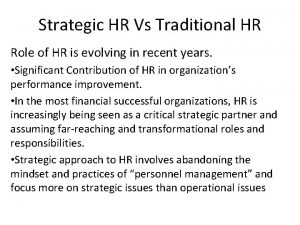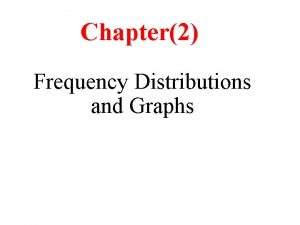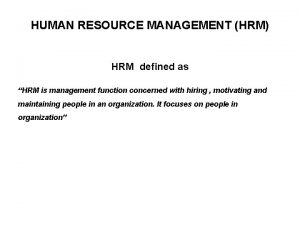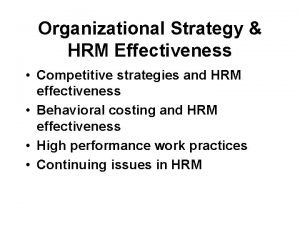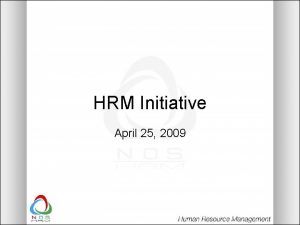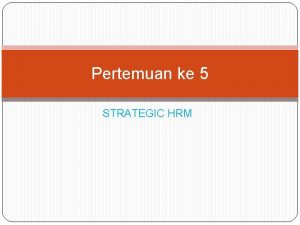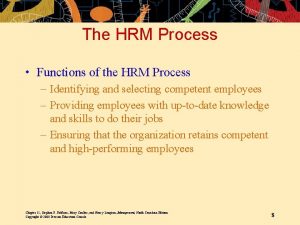SEMINAR IN HRM COURSE SEMINAR IN HRM CLASS


































































- Slides: 66

SEMINAR IN HRM COURSE : SEMINAR IN HRM CLASS : BS COMMERCE SEMESTER : 8 TH TOPIC : COMPENSATION MANAGEMENT EMAIL : FAHEEMORG 85@GMAIL. COM (FOR QUERIES KINDLY EMAIL ON TO THIS ID) 1

Establishing Strategic Pay Plans Learning Objective’s 1. List the basic factors determining pay rates. 2. Define and give an example of how to conduct a job evaluation(Methods of the job evaluation) 3. Explain in detail how to establish a market competitive pay plan. 4. Explain how to price managerial and professional jobs. 5. Describe the importance of total rewards 2

Example of the Walmart • In the grocery business, when Walmart opens a store, the other stores’ usual reaction is to cut costs, particularly wages and benefits. So as Wegmans Food Markets, Inc. , adds more stores and increasingly competes with Walmart, its management needs to decide this: Should we cut pay to better compete based on cost, or pursue a different compensation policy? 1 We’ll see how Wegmans boosted profits by raising pay. 3

1. Basic Factors in Determining Pay Rates • Employee compensation includes all forms of pay going to employees and arising from their employment. It has two main components, direct financial payments(wages, salaries, incentives, commissions, and bonuses) and indirect financial payments (financial benefits like employer-paid insurance and vacations). • In turn, employers can make direct financial payments to employees based on increments of time or based on performance. • Time-based pay still predominates. Blue-collar and clerical workers receive hourly or daily wages, for instance. Others, like managers or Web designers, tend to be salaried and paid weekly, monthly, or yearly. • The second direct payment option is to pay for performance. For example, piecework ties compensation to the amount of production (or number of “pieces”) the worker turns out. Sales commissions tie pay to sales. Many employers’ pay plans combine time-based pay and incentives. 4

Contd: Aligning Total Rewards with Strategy • The compensation plan should first advance the firm’s strategic aims— management should produce an aligned reward strategy ( This means creating a compensation package that produces the employee behaviors the firm needs to achieve its competitive strategy). • Put another way, the rewards should provide a clear pathway between each reward and specific business goals. • We will see that many employers formulate a total rewards strategy to support their strategic aims. • Total rewards encompass traditional pay, incentives, and benefits, but also “rewards” such as more challenging jobs (job design), career development, and recognition. • Table 11 -1 lists illustrative questions to ask when crafting a strategyoriented pay policy. 5

Contd: • Table 11 -1 Do Our Compensation Policies Support Our Strategic Aims? 6

New topic: Equity and Its Impact on Pay Rates (Equity Theory) • Among humans, too, the equity theory of motivation postulates that people • are motivated to maintain a balance between what they perceive as their contributions and their rewards. • Equity theory states that if a person perceives an inequity, a tension or drive will develop that motivates him or her to reduce the tension and perceived inequity. • Research Findings: • Research tends to support equity theory, particularly as it applies to those underpaid. • For example, in one study turnover of retail buyers was significantly lower when the buyers perceived fair treatment in rewards and in how employers allocated rewards. Overpaying can sometimes backfire, too, perhaps “dueto feelings of guilt or discomfort. ” In compensation, one can address : • 1. External equity • 2. Internal equity • 3. Individual equity • 4. Procedural equity 7

Contd: • External equity refers to how a job’s pay rate in one company compares to the job’s pay rate in other companies. • Internal equity refers to how fair the job’s pay rate is when compared to other • jobs within the same company (for instance, is the sales manager’s pay fair, when compared to what the production manager earns? ). • Individual equity refers to the fairness of an individual’s pay as compared with what his or her coworkers are earning for the same or very similar jobs within the company, based on each person’s performance. • Procedural equity refers to the “perceived fairness of the processes and procedures used to make decisions regarding the allocation of pay. ” 8

WHICH TOOLS DOES MANAGERS USES TO ADDRESS EQUITY ISSUES? • For example, they use salary surveys (surveys of what other employers are paying) to monitor and maintain external equity. They use job analysis and comparisons of each job (“job evaluation”) to maintain internal equity. • They use performance appraisal and incentive pay to maintain individual equity. • And they use communications, grievance mechanisms, and employees’ participation to help ensure that employees view the pay process as procedurally fair. • Some firms administer attitude surveys to monitor employees’ pay satisfaction. Questions typically include, “How satisfied are you with your pay? ” and “What factors do you believe are used when your pay isdetermined? ” 9

Contd: • open pay policies role in maintaining equity • An open salary policy is exactly what it sounds like: Everyone's salary is publicized for all to see. Salaries may be kept on a spreadsheet or in an otherwise accessible format, and employees within the organization (and sometimes people outside of it) can see exactly what their co-workers make. • To head off discussions that might prompt feelings of internal inequity, some firms maintain strict secrecy over pay rates, while others publicize them. • However, “open pay” policies can backfire. In one firm, employees vigorously opposed paying a high salary to a great candidate unless everyone else’s pay went up, too, for instance. As of now, the research concerning pay secrecy is inconclusive, and most employers don’t have open pay policies. • For external equity, online pay sites like Salary. com make it easy to see what one could earn elsewhere. 10

New topic: - Job Evaluation Methods • Employers use two basic approaches to setting pay rates: 1. job evaluation methods. 2. Market-based approaches Many firms, particularly smaller ones, simply use a market- based approach. Doing so involves conducting formal or informal salary surveys to determine what others in the relevant labor markets are paying for particular jobs. They then use these figures to price their own jobs. WHAT IS JOB EVALUATION ? • Job evaluation is a formal and systematic comparison of jobs to determine the worth of one job relative to another. 1. Job evaluation aims to determine a job’s relative worth. 2. Job evaluation eventually results in a wage or salary structure or hierarchy (this shows the pay rate for various jobs or groups of jobs). The basic principle of job evaluation is this: Jobs that require greater qualifications, more responsibilities, and more complex job duties should receive more pay than jobs with lesser requirements. 11

Contd: • The basic job evaluation procedure is to compare jobs in relation to one another— for example, in terms of required effort, job complexity, and skills. Q- how will you create a pay plan in which there is internal equity and external equity? • Suppose you know (based on your job evaluation) the relative worth of the key jobs in your firm. You then conduct a salary survey to see what others are paying for similar jobs. By combining the information from the job evaluation and from the salary survey, you are on your way to being able to create a market-competitive pay plan—one where your pay rates are equitable both internally (based on each job’s relative value) and externally (in other words when compared with what other employers are paying). What are compensable factors? • You can use two basic approaches to compare the worth of several jobs. • 1 st , you might decide that one job is more important than another is, and not dig any deeper. • 2 nd you could compare the jobs by focusing on certain basic factors the jobs have in common. Compensation management specialists call these compensable factors. (They are the factors that establish how the jobs compare to one another, and that determine the pay for each job). 12

Contd: How to develop or use existing compensable factors? • Some employers develop their own compensable factors. However, most use factors popularized by packaged job evaluation systems or by federal legislation. For example, the Equal Pay Act uses four compensable factors—skills, effort, responsibility, and working conditions. • The method popularized by the Hay consulting firm emphasizes three factors: know-how, problem solving, and accountability. Walmart uses knowledge, problem-solving skills, and accountability requirements. • Choosing compensable factors plays a big role in job evaluation. You usually compare each job with all comparable jobs using the same compensable factors. However, the compensable factors you use depend on the job and the job evaluation method. For example, “decision making” might make sense for a manager’s job, but not for a cleaner’s job. 13

Preparing for the Job Evaluation Job evaluation is a judgmental process and demands close cooperation among supervisors, HR specialists, and employees and union representatives. The initial steps include: 1. identifying the need for the program, 2. getting cooperation 3. Choosing an evaluation committee. (The committee then performs the actual evaluation). • 1. Identifying the need for job evaluation shouldn’t be difficult. For example, dissatisfaction reflected in high turnover, work stoppages, or arguments may result from paying employees different rates for similar jobs. 2. Getting cooperation 1. Managers may express uneasiness with an informal way of assigning pay rates. 2. Employees may fear that a systematic evaluation of their jobs may reduce their pay rates, so getting employees to cooperate in the evaluation is important. For example, you can tell employees that because of the impending job evaluation program, pay rate decisions will no longer be made just by management whim, and that no current employee’s rate will be adversely affected because of the job evaluation. 3. Choose a job evaluation committee. The committee usually consists of about five members, most of whom are employees. Management has the right to serve on such committees, but employees may view this with suspicion. However a human resource specialist can usually be justified to provide expert assistance. 14

Contd: Once appointed, each committee member should receive a manual explaining both the job evaluation process and how to conduct the job evaluation. The evaluation committee then performs three main functions. 1. First, it usually identifies 10 or 15 key benchmark jobs. These will be the first jobs they’ll evaluate and will serve as the anchors or benchmarks against which the relative importance or value of all other jobs is compared. 2. 2 ND , the committee may select compensable factors (although the human resources department will usually choose these). 3. 3 RD , the committee performs its most important function—actually evaluating the worth of each job. For this, the committee will probably use one of the following methods: 4. Ranking Method 5. Job classification method 6. Point method. 15

1. Job Evaluation Methods: Ranking method • The simplest job evaluation method ranks each job relative to all other jobs, usually based on some overall factor like “job difficulty. ” There are several steps in the job ranking method. 1. 2. 3. 4. 5. 6. 7. Obtain job information. Select and group jobs Select compensable factors Rank jobs. Combine ratings. Compare current pay with what others are paying based on salary survey. Assign a new pay scale. 16

Contd: 1. 2. 3. Obtain job information. Job analysis is the first step. Here job descriptions for each job are prepared, and the information they contain about the job’s duties is usually the basis for ranking jobs. (Sometimes job specifications are also prepared. However, the ranking method usually ranks jobs based on the whole job, rather than on several compensable factors. Therefore, job specifications, which tend to list job demands in terms of compensable factors such as problem solving, decision making, and skills, are not as important with ranking as they are for other job evaluation methods. ) Select and group jobs. It is usually not practical to make a single ranking for all jobs in an organization. The usual procedure is to rank jobs by department or in clusters (such as factory workers or clerical workers). This removes the need for direct comparison of, say, factory jobs and clerical jobs. Select compensable factors. In the ranking method, it is common to use just one factor (such as job difficulty) and to rank jobs based on the whole job. However regardless of the number of factors you choose, explain the definition of the factor(s) to the evaluators carefully so that they all evaluate the jobs consistently. 17

Contd: 4. Rank jobs. For example, each rater gets a set of index cards, each of which contains a brief description of a job. Then they arrange these cards from lowest to highest. Some managers use an “alternation ranking method” to make this procedure more accurate. Here you take the cards, first choosing the highest and the lowest, then the next highest and next lowest, and so forth, until you’ve ranked all the cards. Table 11 -2 illustrates such a job ranking. Jobs in this small health facility rank from orderly up to office manager. ( on slide no. 8) The corresponding current pay scales are shown in the column following the job titles. (After ranking, it is possible to slot additional jobs based on their difficulty between those already ranked and to assign each an appropriate wage rate. ) The ranked listing of jobs enables us to compare each job’s rank with its current pay, and decide if what we are currently paying is internally equitable; we may adjust a job’s pay up or down, based on this. Online programs (for example, go to www. hr-guide. com, click under “Job Evaluation, Ranking, ” and then click “Interactive Ranking Program”) can help you rank (and check the rankings of) your positions. 5. Combine ratings. Usually, several raters rank the jobs independently. Then the rating committee (or the employer) can simply average the raters’ rankings. 6. Compare current pay with what others are paying based on salary survey. Next, we show on the same table (in the middle column) what others in the community 18

Contd: - Another method closely related to ranking method is “The factor comparison method” is a special ranking method. It requires ranking each of a job’s “factors” (such as education required, experience, and complexity), and then adding up the points representing the number of “degrees” of each factor each job has. Employers seldom use it today. 19

2. Job Evaluation Methods: Job Classification • Job classification (or job grading) is a simple, widely used job evaluation method in which raters categorize jobs into groups; all the jobs in each group are of roughly the same value for pay purposes. • We call these groups classes if they contain similar jobs, or grades if they contain jobs that are similar in difficulty but otherwise different. FOR EXAMPLE • In USA the federal government’s pay grade system, a “press secretary” and a “fire chief” might both be graded “GS-10” (GS stands for “General Schedule”). On the other hand, in its job class system, the state of Florida might classify all “secretary IIs” in one class, all “maintenance engineers” in another, and so forth. • In practice, there are several ways to categorize jobs. One is to write class or grade summaries or descriptions (similar to job descriptions); you then place jobs into the classes or grades based on how well they fit these descriptions. • Another is to write a set of compensable factor-based rules for each class (for instance, how much independent judgment, skill, and physical effort does the class of jobs require? ). Then categorize each job according to these rules. • The usual procedure blends these two: the analysts choose compensable factors and then develop short class or grade descriptions that describe each class (or grade) in terms of the amount or level of the factors in those jobs. 20

Contd: For example U. S. government’s classification system uses eight compensable factors: (1) Difficulty and variety of work (2) Supervision received and exercised (3) Judgment exercised (4) Originality required (5) Nature and purpose of interpersonal work relationships (6) Responsibility (7) Experience (8) Knowledge required. Based on these compensable factors, raters write a grade definition like that in Figure 11 -4 (Slide no. 11) This one shows one grade description (for grade GS-7) for the federal government’s pay grade system. • Next the evaluation committee reviews all job descriptions and slots each job into its appropriate grade, by comparing each job description to the rules in each grade description. Thus, the federal government system classifies thepositions automotive mechanic, welder, electrician, and 21 machinist in grade GS-10. •

Contd: - 22

3. Job Evaluation Methods: Point Method • The point method’s overall aim is to determine the degree to which the jobs you’re evaluating contain selected compensable factors. It involves: • Identifying several compensable factors for the jobs • The degree to which each factor is present in each job. FOR EXAMPLE • Assume there are five degrees of the compensable factor “responsibility” a job could contain. • Further, assume you assign a different number of points to each degree of each compensable factor. • Once the evaluation committee determines the degree to which each compensable factor (like “responsibility” and “effort”) is present in a job, it can calculate a total point value for the job by adding up the corresponding degree points for each factor. • The result is a quantitative point rating for each job. • The point method of job evaluation is the most popular job evaluation method today. 23

Contd: • A number of groups (such as the Hay Group, the National Electrical Manufacturer’s Association, and the National Trade Association) have developed standardized point plans. Many thousands of employers use these systems. They contain ready-made factor and degree definitions and point assessments for a wide range of jobs. Employers can often use them with little or no modification. DRAWBACKS OF POINT METHOD • Using job evaluation methods such as the point method can be timeconsuming. Accumulating the information about “how much” of each compensable factor the job contains is a tedious process. The evaluation committees must debate the level of each compensable factor in each job. • They then write down their consensus judgments and compute each job’s point values or rankings. 24

New topic: - Market-competitive Pay Plan How to create a Market-competitive Pay Plan • As we said, many firms simply price their jobs based on what other employers are paying—they just use a market-based approach. However, most employers also base their pay plans on job evaluation methods like those just described. • These evaluations assign values (such as point values) to each job. This helps to produce a pay plan in which each job’s pay is internally equitable, based, as it is, on the job’s value to the employer (as measured, for instance, by how many points it warrants). However, even with the job evaluation approach, managers must adjust pay rates to fit the market. • After all, you want employees’ pay to be equitable internally—relative to what their colleagues in the firm are earning—but also competitive externally—relative to what other employers are paying. • In a market-competitive pay plan a job’s compensation reflects the job’s value in the company, as well as what other employers are paying for similar jobs in the marketplace. Because the point method (or “point-factor method”) is so popular, we’ll use it as the centerpiece of our step-by-step example for creating a market-competitive pay plan. 25

Contd: The 16 steps in creating a market competitive pay plan begin with choosing benchmark jobs. 1. Choose Benchmark Jobs 2. Select Compensable Factors 3. Assign Weights to Compensable Factors 4. Convert Percentages to Points for Each Factor 5. Define Each Factor’s Degrees 6. Determine for Each Factor Its Factor Degrees’ Points 7. Review Job Descriptions and Job Specifications 8. Evaluate the Jobs 9. Draw the Current (Internal) Wage Curve 10. Conduct a Market Analysis: Salary Surveys 11. Draw the Market (External) Wage Curve 12. Compare and Adjust Current and Market Wage Rates for Jobs 13. Develop Pay Grades 14. Establish Rate Ranges 15. Address Remaining Jobs 16. Correct Out-of-Line Rates 26

Contd: 1. Choose Benchmark Jobs • Particularly when an employer has dozens or hundreds of different jobs, it’s impractical and unnecessary to evaluate each of them separately. Therefore, the first step inthe point method is to select benchmark jobs. Benchmark jobs are representative of the jobs the employer needs to evaluate. Like “accounting clerk” they should be common among employers (thus making it easier to survey what competitors are paying for similar jobs). 2. Select Compensable Factors • The choice of compensable factors depends on tradition (as noted, the Equal Pay Act of 1963 uses four compensable factors: skill, effort, responsibility, and working conditions), and on strategic and practical considerations. • For example, if your firm’s competitive advantage is quality, you might substitute “responsibility for quality” for working conditions, or simply add it as a fifth factor. 65 Similarly, using “working conditions” makes little practical sense for evaluating executive jobs. • The employer should carefully define each factor. This is to ensure that the evaluation committee members will each apply the factors with consistency. Figure 11 -5 shows (on top) one such definition, in this case for the factor job complexity. • The human resource specialist often draws up the definitions. 27

Figure 11 -5 shows (on top) one such definition, in this case for the factor job complexity. 28

Contd: 3. Assign Weights to Compensable Factors • Having selected compensable factors, the next step is to determine the relative importance (or weighting) of each factor (for instance, how much more important is “skill” than “effort”? ). This is important because for each cluster of jobs some factors are bound to be more important than others are. Thus, for executive jobs the “mental requirements” factor would carry far more weight than would “physical requirements. ” • To assign weights, we assume we have a total 100 percentage points to allocate for each job. Then (as an illustration), assign percentage weights of 60% for the factor job complexity, 30% for effort, and 10% for working conditions. 4. Convert Percentages to Points for Each Factor • Next, we want to convert the percentage weights assigned to each compensable factor into point values for each factor (this is, after all, the point method). It is traditional to assume we are working with a total of l, 000 points (although one could use some other figure). • To convert percentages to points for each compensable factor, multiply the percentage weight for each compensable factor (from the previous step) by 1, 000. 67 This will tell you the maximum number of points for each compensable factor. Doing so in this case would translate into 1, 000 × 0. 60 = 600 possible points for job complexity, 1, 000 × 0. 30 = 300 points for effort, and 1, 000 × 0. 10 = 100 points for working conditions. 29

Contd: 5. Define Each Factor’s Degrees • Next, split each factor into degrees, and define (write degree definitions for) each degree so that raters may judge the amount or degree of a factor existing in a job. • Thus, for a compensable factor such as “job complexity” you might choose to have five degrees, ranging from “here the job is routine” to “uses independent judgment. ” (Our definitions for each degree are shown in Figure 11 -5 under “Job Complexity Degree Definitions: What to Look For in the Job. ”) • The number of degrees usually does not exceed five or six, and the actual number depends mostly on judgment. • Thus, if all employees work either in a quiet, air-conditioned office or in a noisy, hot factory, then two degrees would probably suffice for the factor “working conditions. ” You need not have the same number of degrees for each factor, and you should limit degrees to the number necessary to distinguish among jobs. 30

Contd: 6. Determine for Each Factor Its Factor Degrees’ Points • The evaluation committee must be able to determine the number of points each job is worth. • To do this, the committee must be able to examine each job and (from each factor’s degree definitions) determine what degree of each compensable factor that job has. For them to do this, we must first assign points to each degree of each compensable factor. For example, in our illustration, we have five possible degrees of job complexity, and the job complexity compensable factor is worth up to 600 points maximum. • In our case, we simply decide that the first degree level of job complexity is worth 120 (or one-fifth of 600) points, the second degree level is worth 240 points, the third degree level is worth 360 points, the fourth degree level is worth 480 points, and the fifth degree is worth the maximum 600 points (see Figure 11 -5). 68 Do this for each factor (as in Table 11 -3). 31

Contd: - 32

Contd: 7. Review Job Descriptions and Job Specifications • The heart of job evaluation involves determining the amount or degree to which the job contains the selected compensable factors such as effort, job complexity, and working conditions. • The team conducting the job evaluation will frequently do so by first reviewing each job’s job description and job specification. As we explained in Job Analysis, it is through the job analysis that the manager identifies the job’s duties and responsibilities and writes the job description and job specification. • Ideally therefore, the job analyst included in the job description and specification information about the compensable factors (such as job complexity) around which the employer plans to build its compensation plan. 33

Contd: 8. Evaluate the Jobs • Steps 1– 7 provide us with the information (for instance, on points and degrees) based on which we can evaluate the jobs. The committee has now gathered the job descriptions and job specifications for the benchmark jobs they will focus on. • Then, from their review of each job description and job specification, the committee determines the degree to which each compensable factor is present in each job. • Thus for, say, a job of master mechanic, the team might conclude (after studying the job description and job specification) that the master mechanic’s job deserves the third degree level of job complexity points, the first degree level of effort, and the first degree level of working conditions. • Finally, we add up these degree points for each job to determine each job’s total number of points the master mechanic job gets 360 + 20 = 440 points from Table 11 -3. This enables us to list a hierarchy of jobs, based upon each job’s points. • What should the pay rate be for each job? Of course, jobs with more points should command higher pay. The question is what pay rate to use. Our company’s current, “internal” pay rates? Or pay rates based on what the 34 “external” market is paying?

Contd: Wage curves play a central role in assigning wage rates to jobs. • The wage curve typically shows the pay rates paid for jobs, relative to the points or rankings assigned to each job by the job evaluation. Figure 11 -6 presents an example. Note that it shows pay rates for jobs on the vertical axis, and point values for these jobs along the horizontal axis. The purpose of the wage curve is to show the relationships between (1) the value of the job (expressed in points) as determined by one of the job evaluation methods and (2) the pay rates for the job. (We’ll see that • many employers may combine jobs into classes or grades. Here the wage curve would show the relationship between average pay rates for each grade, and each grade’s average point value. ) The pay rates on the wage curve are traditionally those now paid by the employer. However, if there is reason to believe the current pay rates are out of step with the market rates for these jobs, the employer will have to adjust them. • One way to do this is to compare a wage curve that shows the jobs’ current wage rates relative to the jobs’ points, with a second curve that shows market wage rates relative to points. We do this as follows. 35

Contd: - 36

Contd: 9. Draw the Current (Internal) Wage Curve • First, to study how each job’s points relates to its current pay rate, we start by drawing an internal wage curve. Plotting each job’s points and the wage rate the employer is now paying for each job (or wage rates, if there are several for each job) produces a scatter plot as in Figure 11 -7 (left). We now draw a wage curve (on the right) through these plots that shows how point values relate to current wage rates. We can draw this wage line by just estimating a line that best fits the plotted points (by minimizing the distances between the plots and the curve). Or w can use regression, a statistical technique. Using the latter will produce a current/ internal wage curve that best fits the plotted points. In any case, we show the results in Figure 11 -7 (right). 37

Contd: 10. Conduct a Market Analysis: Salary Surveys • Next, we must compile the information needed to draw an external wage curve for our jobs, based on what other employers are paying for similar jobs. Salary surveys— surveys of what others are paying—play a big role in pricing jobs. 74 Employers use salary surveys in three ways. • First, they use survey data to price benchmark jobs. Benchmark jobs are the anchor jobs around which they slot their other jobs, based on each job’s relative worth to the firm. • Second, employers typically price 20% or more of their positions directly in the marketplace (rather than relative to the firm’s benchmark jobs), based on a survey of what comparable firms are paying for comparable jobs. (Google might do this for jobs like systems engineer, whose salaries fluctuate widely and often. ) • Third, surveys also collect data on benefits like insurance, sick leave, and vacations for decisions regarding employee benefits. Salary surveys can be formal or informal. Informal phone or Internet surveys are good for checking specific issues, such as when a bank wants to confirm the salary at which to advertise a newly open teller’s job, or whether some banks are really paying tellers an incentive. • Some large employers can afford to send out their own formal surveys to collect compensation information from other employers. These ask about things like number of employees, overtime policies, starting salaries, and paid vacations. 38

Contd: - 39

Contd: 11. Draw the Market (External) Wage Curve • The current/internal wage curve from step 9 is helpful. For example showing, as it does, how a job’s current pay rate compares with its points helps the employer identify jobs for which pay rates are currently too high or too low, relative to other jobs in the company. (For example, if a job’s current wage rate is well above the internal wage curve, it suggests that the present wage rate for that job is inequitably high, given the number of points we’ve assigned to that job. ) • What the current (internal) wage curve does not reveal is whether our pay rates are too high, too low, or just right relative to what other firms are paying. For this, we need to draw a market or external wage curve. • To draw the market/external wage curve, we produce a scatter plot and wage curve as in Figure 11 -8 (left and right). • However, instead of using our firm’s current wage rates, we use market wage rates (obtained from salary surveys). The market/ external wage curve thereby compares our jobs’ points with market pay rates for our jobs. 40

Contd: - 41

Contd: 12. Compare and Adjust Current and Market Wage Rates for Jobs • How different are the market rates other employers are paying for our jobs and the current rates we are now paying for our jobs? To determine this, we combine both the current/internal and market/external wage curves on one graph, as in Figure 11 -9. • The market wage curve might be higher than our current wage curve (suggesting that our current pay rates may be too low), or below our current wage curve (suggesting that our current wage rates might be too high). Or perhaps market wage rates are higher for some of our jobs and lower for others. • Based on comparing the current/internal wage curve and market/external wage curve in Figure 11 -9, we must decide whether to adjust the current pay rates for our jobs, and if so how. • This calls for a policy decision by management. Strategic considerations influence this decision. • Do our strategic aspirations suggest we should pay more, the same, or less than competitors? • For example, we might decide to move our current internal wage curve up (and thereby give everyone a raise), or down (and thereby perhaps withhold pay increases for some time), or adjust the slope of the internal wage curve to increase what we pay for some jobs and decrease what we pay for others. In any case, the wage curve we end up with (the orange line in Figure 11 -10) should now be equitable internally (in terms of the point value of each job) and equitable externally (in terms of what other firms are paying). 42

Contd: Figure 11 -9 Plotting both the market and internal Wage Curves 43

44

Contd: 13. Develop Pay Grades • Employers typically group similar jobs (in terms of points) into grades for pay purposes. • Then, instead of having to deal with hundreds of job rates, you might only have to focus on, say, pay rates for 10 or 12 pay grades. • A pay (or wage) grade is composed of jobs of approximately equal difficulty or importance as determined by job evaluation. If you used the point method of job evaluation, the pay grade consists of jobs falling within a range of points. If the ranking method was used, the grade consists of a specific number of ranks. • If you use the classification system, then your jobs are already categorized into classes (or grades). 45

Contd: 14. Establish Rate Ranges • Most employers do not pay just one rate for all jobs in a particular pay grade. For example, GE Medical won’t want to pay all its accounting clerks, from beginners to long tenure, at the same rate, even though they may all be in the same pay grade. • Instead, employers develop vertical pay (or “rate”) ranges for each of the horizontal pay grades (or pay classes). • These pay (or rate) ranges often appear as vertical boxes within each grade, showing minimum, maximum, and midpoint pay rates for that grade, as in Figure 11 -10. (Specialists call this graph a wage structure. Figure 11 -10 graphically depicts the range of pay rates—in this case, per hour—paid for each pay grade. ) • Alternatively, you may depict the pay range for each class or grade as steps in a table, as in Table 11 -5. Here you will have specific corresponding pay rates for each step within each grade in tabular form. Thus, Table 11 -5 shows the pay rates and steps for most federal government grades. As of the time of this pay schedule, for instance, employees in positions classified in grade GS-10 could be paid annual salaries between $46, 691 and $60, 695, depending on the level or step at which they were hired into the grade, the amount of time they were in the grade, and any merit increases they’ve received. 46

Contd: DEVELOPING RATE RANGES • As in Figure 11 -10, the wage curve usually anchors the average pay rate for each vertical pay range. The firm might then arbitrarily decide on a maximum and minimum rate for each grade, such as 15% above and below the wage curve. • As an alternative, some employers allow the pay range for each grade to become taller (they include more pay rates) for the higher pay ranges, reflecting the greater demands and performance variability inherent in more complex jobs. • As in Figure 11 -10, most employers structure their rate ranges to overlap a bit, so an employee in one grade who has more experience or seniority may earn more than would someone in an entry-level position in the next higher pay grade. • There are several reasons to use pay ranges for each pay grade. First, it lets the employer take a more flexible stance in the labor market. For example, it makes it easier to attract experienced, higher-paid employees into a pay grade at the top of the range, since the starting salary for the pay grade’s lowest step may be too low to attract them. Pay ranges also let companies provide for performance differences between employees within the same grade or between those with different seniorities. • Compensation experts sometimes use compa ratios. The compa ratio equals an employee’s pay rate divided by the pay range midpoint for his or her pay grade. A compa ratio of 1 means the employee is being paid exactly at the pay range midpoint. • If the compa ratio is above 1 then the person’s pay rate exceeds the midpoint pay for the job. If it is below then the pay rate is less than the midpoint. • The compa ratio can help reveal how many jobs in each pay grade are paid above and below competitive market pay rates. 47

48

Contd: 15. Address Remaining Jobs • To this point, we have focused our job evaluation on a limited number of benchmark jobs, as is traditional. We now want to add our remaining jobs to the wage structure. We can do this in two ways. We can evaluate each of the remaining jobs using the same process we just went through. Or we can simply slot the remaining jobs into the wage structure where we feel they belong, without formally evaluating and assigning points to these jobs. • Jobs similar enough to our benchmark jobs we can easily slot into the wage structure. Jobs we’re not sure about should undergo the same job evaluation process; we assign points to them and precisely slot them into the wage structure. 49

Contd: 16. Correct Out-of-Line Rates • Finally, the wage rate the firm is now paying for a particular job may fall well off the wage curve or well outside the rate range for its grade, as illustrated in Figure 11 -6 (page 362). This means that the average pay for that job is currently too high or too low, relative to other jobs in the firm. For underpaid jobs, the solution is clear: Raise the wages of underpaid employees to the minimum of the rate range for their pay grade. • Current pay rates falling above the rate range are a different story. These are “red circle, ” “flagged, ” or “overrates. ” There are several ways to cope with this problem. One is to freeze the rate paid to these employees until general salary increases bring the other jobs into line. A second option is to transfer or promote the employees involved to jobs for which you can legitimately pay them their current pay rates. The third option is to freeze the rate for 6 months, during which time you try to transfer or promote the overpaid employees. If you cannot, then cut the rate you pay these employees to the maximum in the pay range for their pay grade. • The accompanying HR Tools feature explains a streamlined pay plan procedure for small businesses. 50

New Topic: - Pricing Managerial and Professional jobs • • • Developing compensation plans for managers or professionals is similar in many respects to developing plans for any employee. The basic aim is the same: to attract, motivate, and retain good employees. And job evaluation is about as applicable to managerial and professional jobs (below the top executive levels) as to production and clerical ones. There are some big differences though. Managerial jobs tend to stress harder to- quantify factors like judgment and problem solving more than do production and clerical jobs. There is also more emphasis on paying managers and professionals based on their performance or on what they can do, rather than on static job demands like working conditions. And one must compete in the marketplace for executives who sometimes have rock star pay. So, job evaluation, although still important for management jobs, usually plays a secondary role to issues like bonuses, incentives, market rates, and benefits. What Determines Executive Pay? The traditional wisdom is that company size and performance significantly affect top managers’ salaries. Yet early studies showed that these explained only about 30% of CEO pay: “In reality, CEO pay is set by the board taking into account a variety of factors such as the business strategy, corporate trends, and most importantly where they want to be in a short and long term. ” One study concluded that three main factors, job complexity (span of control, the number of functional divisions over which the executive has direct responsibility, and management level), the employer’s ability to pay (total profit and rate of return), and the executive’s human capital (educational level, field of study, work experience), accounted for about twothirds of executive compensation variance. 51

Contd: • In practice, CEOs exercise influence over their boards of directors, so their pay sometimes doesn’t reflect strictly arms-length negotiations. Many employers do use job evaluation for pricing managerial jobs (at least, below the top jobs). The basic approach is to classify executive and management positions into grades, each with a salary range. • As with no managerial jobs, one alternative is to rank the executive and management positions in relation to each other, then group into classes those of similar value. However, firms also use the job classification and point methods, with compensable factors like position scope, complexity, and difficulty. As with any jobs, job analysis, salary surveys, and the fine-tuning of salary levels around wage curves play roles. • Shareholder activism and government oversight have tightened the restrictions on what companies pay top executives. For example, the banking giant HSBC shelved plans to raise its CEO’s pay by over a third after shareholders rejected the proposals. 52

Contd: • • Compensation for a company’s top executives usually consists of four main elements. Base pay includes the person’s fixed salary as well as, often, guaranteed bonuses such as “ 10% of pay at the end of the fourth fiscal quarter, regardless of whether the company makes a profit. ” Short-term incentives are usually cash or stock bonuses for achieving short-term goals, such as year-to-year sales revenue increases. Long-term incentives aim to encourage the executive to take actions that drive up the value of the company’s stock and include things like stock options; these generally ive the executive the right to purchase stock at a specific price for a specific period. Finally, executive benefits and perks include things such as supplemental executive retirement pension plans. With so many complicated elements, employers must also be alert to the tax and securities law implications of their executive compensation decisions. Salary is traditionally the cornerstone of executive compensation. On it, employers layer benefits, incentives, and perquisites—all normally conferred in proportion to base pay. Procter & Gamble Co. ’s CEO was paid $15. 2 million recently, including a base salary of $1. 6 million, a cash-based bonus of $2. 4 million, stock options valued at $4. 4 million, stock awards of $6. 45 million, plus perks such as air travel. 90 Top executive compensation packages can be whoppers. The CEO of Oracle earned just over $96 million in one recent year, and the CEO of Walt Disney Corporation $37. 1 million. But overpaid as many critics may think they are, one expert says CEOs with the highest 20% of compensation produced stock returns 60% greater than those of other firms in their industries. Executive compensation emphasizes performance (discussed in Chapter 12) more than do other employees’ pay plans, since organizational results reflect executives’ contributions more directly than those of lowerechelon employees. Indeed, boards are boosting the emphasis on performance-based pay (in part due to shareholder activism). The big issue here is identifying the appropriate performance measures. Typical shortterm measures include revenue growth and operating profit margin. Long-term measures include rate of return above some predetermined base. 53

Contd: Compensating Professional Employees • In compensating professionals, employers should first ensure that the person is actually a “professional” under the law. The Fair Labor Standards Act “provides an exemption from both minimum wage and overtime pay for employees employed as bona fide executive, administrative, professional and outside sales employees. ” • However, calling someone a professional doesn’t make him or her one. In addition to earning at least $455 per week, the person’s main duty must “be the performance of work requiring advanced knowledge, ” and “the advanced knowledge must be customarily acquired by a prolonged course of specialized intellectual instruction. ” 95 • One company hired a high school graduate as an exempt “product design specialist II, ” earning $62, 000 per year. The job required 12 years of relevant experience, but no particular education. The court ruled the job was nonexempt. • Beyond that, compensating professional employees like engineers presents unique problems. Analytical jobs emphasize compensable factors such as creativity and problem solving, ones not easily compared or measured. Furthermore, 54

Contd: • how do you measure performance? For example, the success of an engineer’s design depends on how the firm develops and markets it. Employers can use job evaluation for professional jobs. Compensable factors here tend to focus on problem solving, creativity, job scope, and technical knowledge and expertise. Firms use the point method and job classification. • Yet, in practice, firms rarely on just job evaluation for pricing professional jobs. Factors like creativity (as noted) are hard to measure, and non-pay issues often influence professionals’ job decisions. For example, a few years ago Google raised its employees’ salaries by 10% in the face of defections by even their highest-paid professionals, such as the head of its Chrome OS team, to Facebook. • Many of these Google professionals, although well paid by most standards, still felt underpaid. Some moved to jobs they hoped would have more challenges. Others may have sought younger firms with new stock options. • Most employers therefore emphasize a market-pricing approach for these jobs. • They price professional jobs in the marketplace as best they can, to establish the values for benchmark jobs. Then they slot these benchmark jobs and their other professional jobs into a salary structure. Each professional discipline (such as engineer) usually ends up having four to six grade levels, each with a broad salary range. • This helps employers remain competitive when bidding for professionals who literally have global employment possibilities. 55

New Topic : - Contemporary topics in compensation • In this final section, we’ll look at five important contemporary compensation topics: 1. 2. 3. 4. 5. COMPETENCY-BASED PAY, COMPARABLE WORTH, BOARD OVERSIGHT OF EXECUTIVE PAY, AND TOTAL REWARDS. BROADBANDING, 56

Contd Competency-Based Pay • Some managers question whether job evaluations that slot jobs into narrow cubbyholes (“Machinist I, ” “Machinist II, ” and so on) might not actually be counterproductive. For example, high-performance work systems depend on flexible multiskilled job assignments and on teamwork, and there’s no place here for employees to say, “That’s not my job. ” • Competency-based pay aims to avoid that problem. With competency (generally skill or knowledge-based) pay, you pay the employee for the skills and knowledge he or she is capable of using rather than for the responsibilities or title of the job currently held. • Experts variously call this competence-, knowledge-, or skillbased pay. With competency-based pay, an employee in a class I job who could (but may not have to at the moment) do class II work gets paid as a class II worker, not a class I. • Competencies are demonstrable personal characteristics such as knowledge, skills, and personal behaviors such as leadership. Why pay employees based on the skill levels they achieve, rather than based on the jobs they’re assigned to? With more companies organizing around teams, you want to encourage employees to get and to use the skills required to rotate among jobs. 57

Contd • In practice, competency-based pay usually comes down to pay for knowledge, or skill based pay. Most such pay programs generally contain five elements. The employer defines specific required skills and chooses a method for basing the person’s pay on his or her skills. A training system lets employees acquire skills. There is a formal competency testing system. And, the work is designed so that employees can easily move among jobs of varying skill levels. • BP lists the minimum level for each skill (such as Technical Expertise, and Problem Solving) someone holding this job must attain. As an employee achieves each level of each skill, he or she would receive a bump in pay. The accompanying JLG program feature shows another example. 58

Comparable Worth • Comparable worth refers to the requirement to pay men and women equal wages for jobs that are dissimilar but of comparable value (for instance measured in points) to the employer. This may mean comparing dissimilar jobs, such as nurses to truck mechanics. The question “comparable worth” seeks to address is this: Should you pay women who are performing jobs equal to men’s or just comparable to men’s the same as men? • Comparable worth has implications for job evaluation. Virtually every comparable worth case that reached court involved the point method of job evaluation. • By assigning points to dissimilar jobs, point plans facilitate comparability ratings among different jobs. Should employers still use point plans? Perhaps the wisest approach is for employers to price their jobs as they see fit (with or without point plans), but to also ensure that women have equal access to all jobs. In other words, eliminate sex segregated jobs. 59

Diveristy Counts: The Pay Gap • All this notwithstanding, women in the United States earn only about 81% as much as men. In general, education may reduce the wage gap somewhat. But gaps remain, even among the most highly trained. For example, new female medical doctors recently earned about $17, 000 per year less than their male counterparts did. 114 • Reasons put forward for the male-female gap range from the outdated notion that employers view women as having less leverage, to the fact that professional men change jobs more often (gaining more raises in the process) and that women tend to end up in departments that pay less. 115 In any case, it’s a problem employers should recognize and address. 60

Contd Board Oversight of Executive Pay • There are various reasons why boards are scrutinizing their executives’ pay more than in the past. The Dodd. Frank Law of 2010 requires that American companies give shareholders a “say on pay. ” Law firms are filing class-action suits demanding information from companies about their senior executive pay decisions. 116 The Financial • Accounting Standards Board requires that most public companies recognize as an expense the fair value of the stock options they grant. • The Sarbanes-Oxley Act makes executives personally liable, under certain conditions, for corporate financial oversight lapses. The chief justice of Delaware’s Supreme Court said that governance issues, shareholder activism, and other changes have “created a new set of expectations for directors. ” • The Securities and Exchange Commission (SEC) requires filing detailed compensation-related information, including a listing of all individual “perks” or benefits if they total more than $100, 000. • The net result is that lawyers specializing in executive pay suggest that boards of directors (whose compensation committees usually make these pay decisions in large firms) ask themselves these questions: ● Has our compensation committee identified its duties and processes? ● Is our compensation committee using the appropriate compensation advisors? ● Are there particular executive compensation issues that our committee should address? ● Do our procedures demonstrate diligence and independence (including careful deliberations and records)? ●Is our committee appropriately communicating its decisions? How will shareholders react? 61

Employee Engagement guide For Managers • Total Rewards Programs • Total rewards is an important concept in compensation management. People bring to their jobs many needs—for challenging work and for respect and appreciation, for instance—not all of which are satisfied by pay or bonuses. “‘Total rewards’ encompass not only compensation and benefits but also personal and professional growth • opportunities and a motivating work environment. ” • It includes not just traditional financial rewards (wages and incentives plus benefits and perks), but also nonfinancial and intangible rewards such as recognition, the nature of the job/ quality of work, career development opportunities, good relationships with managers and colleagues, organizational justice, trust in employees, feeling of being valued and involved, opportunities for promotion, and a great work climate. • Total rewards also include recognition programs and redesigned jobs telecommuting programs, health and well-being programs, and training and career development. 62

Total Rewards and Employee Engagement • When it comes to employee engagement, both material and non-material rewards—total rewards—seem essential. For example, one study found that base pay and benefits alone were weakly related to engagement. • However, intangible rewards (such as the nature of the job/quality of work and career development opportunities) had high or very high impacts on engagement and performance, when combined with base salary and short-term incentives or bonuses. • It’s therefore not surprising that many high-engagement employers do emphasize total rewards. • For example, the values laid out in Toyota’s famous “The Toyota Way” include mutual trust and respect, stable employment, helping employees to develop their technical skills, and “support for production staff combining work with childcare, career design support, and raising of corporate awareness. ” Disney emphasizes providing employees/cast members with a total rewards package that includes pay plus various benefits and career development opportunities. • Similarly, many “Best Companies to Work For” emphasize intangible rewards. For example, one top executive at Net. App takes an opportunity to call and thank several employees each day for their efforts, and Whole Foods emphasizes employee involvement, for instance letting employees vote on new hires and see what all Whole Foods employees earn. • At SAS there is stimulating work, an empowering management philosophy, flexible work, and an emphasis on being happy at work. • In addition to encouraging such rewards, the employer should issue total reward statements periodically. List all the rewards—financial and nonfinancial—the company offers, and note their importance to the employees’ overall well-being. Doing so increases 63 their impact.

Broadbanding • Broadbanding Means collapsing salary grades into just a few wide levels or bands, each of which contains a relatively wide range of jobs and pay levels. Figure 11 -11 illustrates this. Here, the company’s previous six pay grades are consolidated into two broad grades or “broadbands. ” • A company may create broadbands for all its jobs, or for specific groups such as managers or professionals. The (vertical) pay rate range of each broadband is relatively large, since it ranges from the minimum pay of the lowest grade the firm merged into the broadband up to the maximum pay of the highest merged grade. • Thus, for example, instead of having 10 salary grades, each of which contains a salary range of $15, 000, the firm might collapse the 10 grades into three broadbands, each with a set of jobs such that the difference between the lowest- and highest-paid jobs might be $40, 000 or more. For the jobs that fall in this broadband, there is therefore a much wider range of pay rates. • You can move an employee from job to job within the broadband more easily, without worrying about the employee’s moving outside the relatively narrow rate range associated with a traditional narrow pay grade. • Broadbanding injects greater flexibility into employee pay. For example, “the employee who needs to spend time in a lower-level job to develop a certain skill set can receive higherthan-usual pay for the work, a circumstance considered impossible under traditional pay systems. ” • Conversely, employees assigned to traditional narrowly defined pay grades may take a “that’s not my job” attitude and focus on their usual assigned duties 64

Contd 65

THANK YOU FOR READING THIS IS THE END OF THE COMPENSATION MANAGEMENT. 66
 Traditional vs strategic hrm
Traditional vs strategic hrm Difference between domestic hrm and international hrm
Difference between domestic hrm and international hrm 5p model of hrm
5p model of hrm Half brick wall vs one brick wall
Half brick wall vs one brick wall Course title and course number
Course title and course number Course interne moyenne externe
Course interne moyenne externe Today class or today's class
Today class or today's class Package mypackage class first class body
Package mypackage class first class body Introduction to ooad
Introduction to ooad How to calculate mode for grouped data
How to calculate mode for grouped data Class i vs class ii mhc
Class i vs class ii mhc Abstract concrete class relationship
Abstract concrete class relationship How to get median class in grouped data
How to get median class in grouped data Sd and sdelta
Sd and sdelta Discrimination training
Discrimination training Therapeutic class and pharmacologic class
Therapeutic class and pharmacologic class Class maths student student1 class student string name
Class maths student student1 class student string name Categorical frequency distribution example
Categorical frequency distribution example In greenfoot, you can cast an actor class to a world class?
In greenfoot, you can cast an actor class to a world class? Java dynamic class loading
Java dynamic class loading Esd class levels
Esd class levels Class diagram example
Class diagram example Class 2 class 3
Class 2 class 3 Public class test subject extends test class
Public class test subject extends test class Package mypackage class first class body
Package mypackage class first class body Class third class
Class third class What is class attribute in java
What is class attribute in java Component class has composite class as collaborator
Component class has composite class as collaborator Strategic hrm models
Strategic hrm models Why is forecasting important in human resource planning
Why is forecasting important in human resource planning Difference between hrd and hrm
Difference between hrd and hrm Hr mastery
Hr mastery Sub human resources
Sub human resources Redundancy in hrm
Redundancy in hrm Hrm practices
Hrm practices Hr selectietool
Hr selectietool Health and safety in hrm
Health and safety in hrm Nature of hrm
Nature of hrm David guest model of hrm
David guest model of hrm Methods of training in human resource management
Methods of training in human resource management Establishing pay rates
Establishing pay rates Eeo compliance in job analysis
Eeo compliance in job analysis Resource management importance
Resource management importance Outplacement in hrm
Outplacement in hrm Human resource planning steps
Human resource planning steps Prime hrm maturity level
Prime hrm maturity level Managerial judgement technique in hrm example
Managerial judgement technique in hrm example Significance of hrm
Significance of hrm Nature of hrm
Nature of hrm International hrm definition
International hrm definition Objectives of ihrm
Objectives of ihrm Short case study on international hrm with solution
Short case study on international hrm with solution What is industrial relations in hrm
What is industrial relations in hrm Lms hrm integration
Lms hrm integration Types of appraisal methods in hrm
Types of appraisal methods in hrm The commodity concept of hrm
The commodity concept of hrm Hr policies and practices
Hr policies and practices Management is universal and everywhere
Management is universal and everywhere Operative functions of hrm
Operative functions of hrm Michigan model of hrm
Michigan model of hrm 8 steps of job analysis
8 steps of job analysis Job analysis
Job analysis Integration in hrm
Integration in hrm What is hrm
What is hrm Stability index in hrm
Stability index in hrm Human resource planning wikipedia
Human resource planning wikipedia What is hrm
What is hrm
